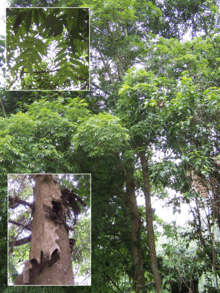Oreomunnea mexicana
Oreomunnea mexicana is a species of plant in the family Juglandaceae, which grows in the tropical rain forests of Mexico, Guatemala, Nicaragua, Costa Rica, and Panama at altitudes from 1–1.7 km. Common names include guayabo amarillo and remiendo. The chromosome number is 2n = 32.
| Oreomunnea mexicana | |
|---|---|
 | |
| Scientific classification | |
| Kingdom: | Plantae |
| Clade: | Tracheophytes |
| Clade: | Angiosperms |
| Clade: | Eudicots |
| Clade: | Rosids |
| Order: | Fagales |
| Family: | Juglandaceae |
| Genus: | Oreomunnea |
| Species: | O. mexicana |
| Binomial name | |
| Oreomunnea mexicana (Standl. J.-F. Leroy) | |
| Subspecies | |
|
O. mexicana subsp. costaricensis Stone | |
Synonymy
Engelhardia nicaraguensis Molina[1] and E. mexicana Standl. are synonyms for O. mexicana subsp. mexicana.[2]
Tree
O. mexicana grows to 30 m or more, up to 1.5m DBH, often with buttresses, and superficially resembles a walnut (Juglans sp.). The bark on a mature tree exfoliates (It does not on O. pterocarpa). The heartwood is pink. The pith is solid (not chambered, as in Juglans). The buds are protected by leaf primordia, with a fine coating of yellow scales (O. pterocarpa has glabrous primordia.[2]
Leaves
The petioles of the opposite, coriaceous, pinnately compound leaves are glabrous at the base (O. pterocarpa is hirsute). The petioles are short (less than 3.3 cm) as are the petiolules of the opposite leaflets (less than 3 mm). The leaflets, up to 1 dm in length, are 4-5 times as long as they are wide. The upper surface of the leaf is glaucous; the underside has a light yellow-brown peltate bloom.[2]
Flowers and fruit
The inflorescences are panicles, and may be androgynous (containing a single spike of pistalate flowers flanked by several staminate catkins), entirely staminate, or entirely pistalate. The fruit bears three wings on a globose nut, approximately 7 mm in diameter. Germination is hypogeal: the first two aerial leaves are pinately compound and opposite; for the next 3-6 dm, the leaves are placed alternately.[2]
References
- IMolina R., A. "Two New Nicaraguan Juglandaceae" Fieldiana: Botany 31(16)357-359. Field Museum of Natural History, Chicago, IL. 1968
- D. E. Stone, "New World Juglandaceae, III. A New Perspective of the Tropical Members with Winged Fruits" Annals of the Missouri Botanical Garden 59(2)p. 308. Missouri Botanical Garden Press. 1972
| Wikimedia Commons has media related to Oreomunnea mexicana. |